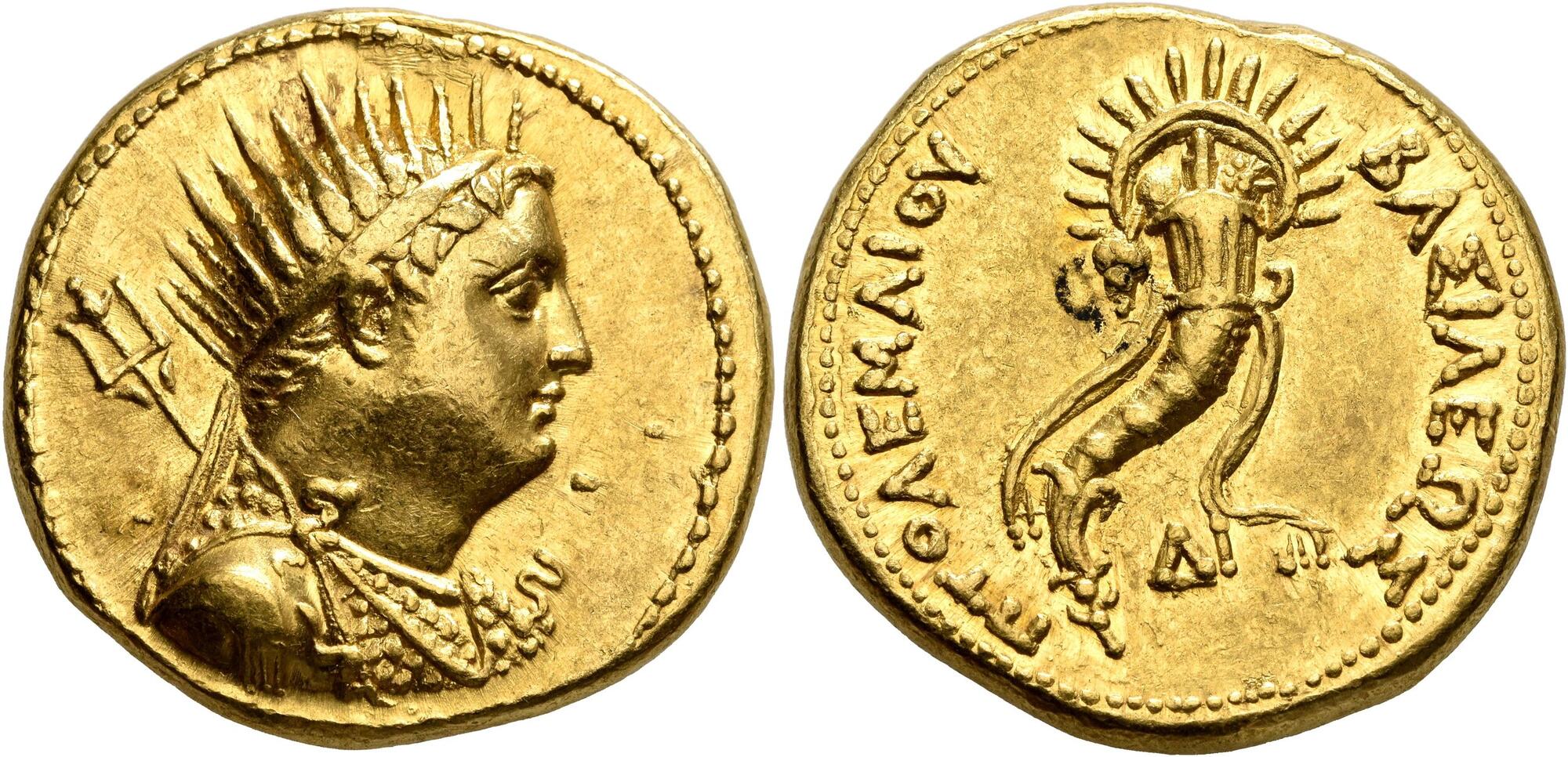S 2065 - Alexandria (Ptolemy III), gold, mnaieia (219-217 BCE)
From SILVER
219 BCE - 217 BCE Gold 37,196 kg
Description
| ObverseInscription or printing placed on the obverse.: | Radiate and diademed bust of the deified Ptolemy III to right, wearing aegis and with trident over his left shoulder |
| ReverseInscription or printing placed on the reverse.: | ΒΑΣΙΛΕΩΣ ΠΤΟΛΕΜΑΙΟΥ (Greek).Radiate cornucopiae bound with royal diadem, below, ΔΙ |
Mint and issuing power
| MintIdentifies the place of manufacture or issue of a numismatic object.: | Alexandria | Ancient regionAncient region.: | Egypt | Modern countryModern country: Egypt | AuthorityIdentifies the issuing power. The authority can be "pretended" when the name or the portrait of X is on the coin but he/she was not the issuing power. It can also be "uncertain" when there is no mention of X on the coin but he/she was the issuing power according to the historical sources: | Ptolemaic dynasty (323-30 BC), Ptolemy III Euergetes (Ptolemaic king, 246-222 BC) |
Chronology
| FromIdentifies the initial date in a range assigned in a numismatic context. | 219 BCE | toIdentifies the final date in a range assigned in a numismatic context.. | 217 BCE | PeriodTime period of the numismatic object.: Hellenistic 323-30 BC |
Physical description
| MetalThe physical material (usually metal) from which an object is made.: | Gold |
Median weightMedian of the weights of numismatic objects (in grams). in grams | 27.80 | DenominationTerm indicating the value of a numismatic object. Examples: tetradrachm, chalkous, denarius.: | mnaieion |
StandardStandard.: | Ptolemaic |
Image

S2065 Alexandria manieia Ptolemy III.jpg [1]
References
| Die study referencePublication of the study: | Van Driessche 19871Van Driessche 1987, Olivier - Lorber 20132Olivier - Lorber 2013, p. 108-114, n° 1-263 | ||
| Coin series referenceReference to coin series study: | Sear II3Sear II, n° 7825, CPE I4CPE I, n° 888 | ||
Obverse dies distribution
| FrequencyFrequency of specimen in distribution. ᵖ | Number of obversesNumber of obverse dies. ᵖ (o) | % (o) | Number of coinsNumber of coins. (n) | % (n) | Die nameName(s) of the die(s). |
| 3 | 1 | 14.29 | 3 | 1.14 | 2 |
| 5 | 1 | 14.29 | 5 | 1.9 | 7 |
| 8 | 1 | 14.29 | 8 | 3.04 | 6 |
| 27 | 1 | 14.29 | 27 | 10.27 | 1 |
| 31 | 1 | 14.29 | 31 | 11.79 | 5 |
| 80 | 1 | 14.29 | 80 | 30.42 | 4 |
| 109 | 1 | 14.29 | 109 | 41.44 | 3 |
| Total | 7 of 7 | 100.03 | 263 of 263 | 100 |
Reverse dies distribution
no distribution is available
Quantification
| Number of obversesNumber of obverse dies. ᵖ (o) | 7 | Number of singletons (o1)The number of singleton coins. ᵖ | |
| Number of reverse diesNumber of reverse dies. (r) | 24 | Number of coinsNumber of coins. (n) | 263 |
| Coins per obverse dieNumber of coins per obverse die. (n/o) | 37.57 | Coins per reverse dieNumber of coins per reverse die. (n/r) | 10.96 |
| Reverse per obverse ratioRatio of obverse dies divided by reverse dies. (r/o) | 3.43 | Percentage of singletons (o1)number of coins (n) divided by the number of singletons (o1) ᵖ | % |
| Original number of dies (O) (Carter 1983 formula)The estimation of the number of coins according to Carter 1983 ᵖ | 6.69 | Coins struck if 20,000 as average productivity per dieCoins made if the average productivity for obverses (according to Carter) is 20,000. ᵖ | 133,800 |
| Original number of dies (O) (Esty 2011 formula)The estimation of the number of coins according to the singleton formula in Esty 2011 ᵖ (O) | 7.19 | Survival rate if 20,000 as average productivity per dieSurvival rate if average productivity is 20,000. ᵖ | 0.00197 |
| Coverage (o = % of O) (Esty 1984 formula)Esty 1984 - coverage (% of O) ᵖ (o = % of O) | % | Die productivity if survival rate 1/2,000Average productivity if survival rate is 1/2,000. ᵖ | 78,624.81 |
| Weight of silver (in kg) if 20,000 coins per die (O = Carter formula)Carter 1983 * Median weight * 20000 (*10 if gold or electrum) ᵖ | 37,196 kg <br /> 37,196 kg | Die productivity if survival rate 1/5,000Average productivity if survival rate is 1/5,000. ᵖ | 196,562.03 |
Remarks
Most likely two workstations